15 years one-stop China custom CNC machining parts factory
 674 |
Published by VMT at Sep 04 2024
674 |
Published by VMT at Sep 04 2024
Threaded holes are fundamental elements in engineering and manufacturing, providing a means for assembling and securing parts with bolts, screws, or other fasteners. This comprehensive guide explores the intricacies of machining threaded holes, including the types, features, and processing technologies involved. Additionally, it covers the advantages and disadvantages of threaded holes, their applications across various industries, and the differences between drilling, tapping, and threading. By understanding these aspects, manufacturers and engineers can optimize their processes, ensuring precision and durability in CNC machined parts.
A threaded hole is a hole with internal threads that allow a bolt, screw, or other threaded fastener to be inserted and securely held in place. The threads provide a helical groove inside the hole, which matches the threads on the fastener, creating a strong mechanical bond. Threaded holes are essential for assembling components in various industries, including automotive, aerospace, electronics, and consumer goods. They are commonly created using tapping or threading processes, which involve cutting or forming the threads within the hole to precise dimensions.
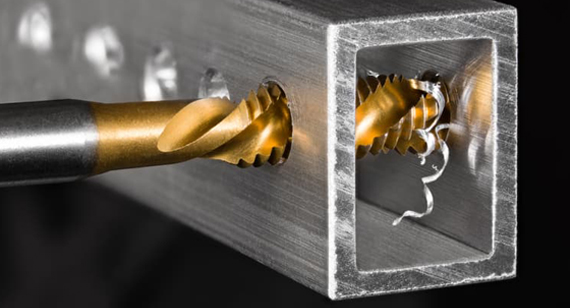
In engineering and manufacturing, a threaded hole is a crucial feature that enables the connection and assembly of multiple parts into a cohesive structure. It allows for removable and adjustable connections, which are essential for maintenance, repair, and assembly processes. Threaded holes are meticulously designed and manufactured to ensure that they meet the required specifications, such as thread size, pitch, and depth. Precision is paramount, especially in high-stakes industries like aerospace and automotive, where even minor deviations can lead to failure of the assembly. Therefore, CNC machining services play a vital role in creating threaded holes with high accuracy and consistency.
Threaded holes are often represented in engineering drawings using specific symbols to indicate their characteristics. These symbols typically include the thread size, pitch, and type (e.g., metric or unified thread), as well as any special features such as depth or tapering. For instance, a metric threaded hole might be denoted as "M10x1.5," indicating a 10mm diameter with a 1.5mm pitch. Understanding these symbols is essential for machinists and engineers to ensure the correct implementation of threaded holes in manufacturing processes.
Threaded holes have several key features that define their functionality and application:
Aperture: The aperture, or diameter, of the threaded hole must match the corresponding fastener's size. Proper sizing ensures a secure fit and reliable performance in the assembled product.
Thread Type: The thread type refers to the shape and profile of the threads, such as metric (M) or unified national thread (UNC/UNF). Different industries and regions may prefer specific thread types based on standards and application requirements.
Thread Size: The thread size is determined by the diameter of the thread and the number of threads per inch (TPI) or the pitch in millimeters. This dimension is critical for ensuring compatibility between the threaded hole and the fastener.
Pitch: The pitch is the distance between adjacent threads. It affects the strength and durability of the threaded connection. A finer pitch offers more threads per unit length, which can provide a stronger hold, especially in softer materials.
Depth: The depth of the threaded hole determines how far the fastener can be inserted. Proper depth ensures the full engagement of the threads, which is vital for the structural integrity of the assembly.
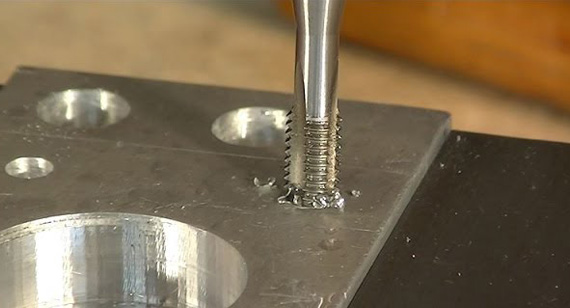
Threaded holes are integral to manufacturing, offering several critical benefits:
Connection: Threaded holes provide a secure and reliable means of connecting parts, allowing for strong mechanical assemblies. This is particularly important in applications where components must be tightly fastened to withstand mechanical stresses and loads.
Convenient Transportation: Threaded holes allow for easy disassembly and reassembly of components, making transportation and maintenance more manageable. This is essential in industries like aerospace and automotive, where components often need to be removed and reinstalled during repairs or upgrades.
Simple Operation: Threaded holes enable quick and straightforward assembly processes, reducing manufacturing time and labor costs. This simplicity is especially valuable in high-volume production environments, where efficiency and consistency are critical.
There are several methods for creating threaded holes, each with its own advantages and applications:
Thread Tapping: Thread tapping involves cutting internal threads into a pre-drilled hole using a tool called a tap. This method is widely used in CNC processing parts due to its accuracy and the ability to produce threads in various materials. Tapping is ideal for creating threads in smaller holes and is commonly used in both high-volume production and custom CNC processing.
Thread Milling: Thread milling is a process where threads are machined using a rotating cutting tool that moves along the path of the thread. This method allows for the creation of threads with high precision and is especially useful for large-diameter holes or when threading hard materials. Thread milling is often preferred in CNC processing services when dealing with complex geometries or requiring fine-tuned thread dimensions.
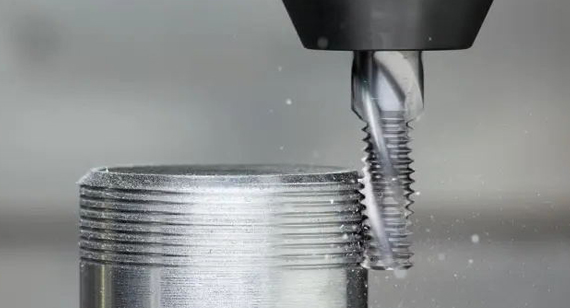
Thread Rolling: Thread rolling is a non-cutting process that forms threads by deforming the material using high-pressure rollers. This method produces stronger threads due to work hardening and is typically used for high-strength applications. Thread rolling is more common in mass production settings where the consistency and strength of the threads are paramount.
In some cases, threaded holes are created using non-machining methods, which can be more efficient or suitable for specific applications:
Welding Inserts: Welding inserts are pre-threaded components that are welded into place within a hole. This method is often used in materials that are difficult to tap or where additional strength is needed. Welding inserts are commonly used in applications where the material's properties make traditional threading challenging.
Press-Fit Inserts: Press-fit inserts are threaded components that are pressed into a pre-drilled hole. This method is quick and easy, providing a secure and durable thread in materials that may not hold a thread well on their own, such as plastics or soft metals. Press-fit inserts are often used in electronics and consumer goods, where lightweight and low-cost materials are prevalent.
Tapping is a common method for creating threaded holes, and it involves several steps to ensure accuracy and quality.
Step 1: Gather Necessary Tools and Materials
Before beginning the tapping process, it's essential to gather all necessary tools and materials. These include:
Drill (Handheld or Drill Press): A drill is needed to create the initial hole before tapping. The choice between a handheld drill and a drill press depends on the precision required and the size of the workpiece.
Drill Bits: Select the correct size drill bit according to the tap drill chart. The drill bit size is critical for ensuring the threads are properly formed and fit the fastener.
Taps: Various taps are used in the tapping process, including taper taps, plug taps, and bottom taps. Each type serves a specific purpose depending on the hole depth and threading requirements.
Tap Shanks (Tap Wrenches): Tap shanks or wrenches are used to hold and turn the tap during the threading process.
Cutting Fluid or Tapping Lubricant: Lubrication is essential to reduce friction, prevent tap breakage, and achieve clean, precise threads.
Safety Glasses and Gloves: Safety gear is crucial to protect against metal shavings and other hazards during the tapping process.
Step 2: Select the Right Tap and Drill
Selecting the appropriate tap and drill bit is critical for achieving accurate and durable threads. The tap should match the thread size and type required for the application. The drill bit size should be chosen based on the material being tapped and the tap drill chart to ensure proper thread engagement.
Step 3: Drill Holes
Drill the initial hole to the correct depth and diameter using the selected drill bit. Ensure the hole is straight and clean, as this will affect the accuracy of the threading process. For deeper holes, it's essential to drill incrementally, clearing chips and debris to prevent the drill bit from binding or breaking.
Step 4: Prepare to Tap
Before tapping, apply cutting fluid or tapping lubricant to the hole and the tap. This lubrication reduces friction, helps remove metal chips, and prevents the tap from binding. Align the tap with the hole, ensuring it is straight and centered.
Step 5: Tap
Begin tapping by turning the tap slowly and steadily. Use a tap wrench to maintain even pressure and avoid tilting the tap, which could cause misalignment or damage the threads. For through holes, continue turning the tap until it exits the other side. For blind holes, proceed carefully to avoid bottoming out, and periodically reverse the tap to break and clear chips.
Drilling a hole before tapping is a crucial step in the threading process. To drill a hole properly, first select the appropriate drill bit size based on the tap drill chart, which provides the correct dimensions for different thread sizes. Use a drill press for precise control, especially when drilling deep or narrow holes. If using a handheld drill, ensure that the drill is perpendicular to the workpiece to avoid creating an angled or off-center hole. Drilling the hole to the correct depth is also essential, particularly for blind holes, where over-drilling could compromise the material's integrity.
Advantages:
Secure Fixation: Threaded holes provide a strong, reliable connection between components, ensuring that parts remain securely fastened even under stress or vibration.
Space Efficiency: Threaded holes allow for compact assemblies, as they do not require additional hardware like nuts. This is particularly beneficial in applications where space is limited.
Structural Integrity: Properly threaded holes contribute to the overall structural integrity of an assembly, distributing loads evenly and preventing components from shifting or loosening over time.
Easy Maintenance: Threaded connections are easy to disassemble and reassemble, making maintenance, repairs, and upgrades more straightforward.
Disadvantages:
Thread Wear: Over time, the threads in a hole can wear down, particularly in frequently disassembled assemblies. This wear can reduce the effectiveness of the connection and may require repair or replacement.
Risk of Cross-Threading: Cross-threading occurs when a fastener is misaligned during insertion, damaging the threads and potentially rendering the hole unusable.
Limited Load Capacity: Threaded holes have a limited load capacity compared to other fastening methods, such as welding or riveting. Exceeding this capacity can lead to thread stripping or fastener failure.
Potential for Tap Breakage: During the tapping process, there is a risk of tap breakage, especially when working with hard materials or deep holes. A broken tap can be difficult to remove and may require specialized tools or even scrapping the part.
Threaded holes are utilized in a wide range of industries and applications:
Automotive Industry: Threaded holes are used extensively in automotive manufacturing for assembling engines, transmissions, chassis components, and other critical systems. They provide reliable connections that withstand the stresses and vibrations of vehicle operation.
Aerospace Industry: In aerospace, precision CNC processing parts often rely on threaded holes for assembling aircraft components, including airframes, landing gear, and avionics systems. The high precision and reliability of threaded connections are essential in this industry.
Electronics and Consumer Goods: Threaded holes are used in electronics for assembling enclosures, mounting circuit boards, and securing components within devices. They are also common in consumer goods, where they provide a means of assembling various parts efficiently.
Medical Devices: In the medical device industry, threaded holes are used to assemble surgical instruments, diagnostic equipment, and implants. The precision and reliability of these connections are crucial for patient safety and device functionality.
Marine and Offshore Applications: Threaded holes are used in the marine and offshore industries for assembling equipment that must withstand harsh environments, including saltwater exposure and extreme weather conditions. These applications require corrosion-resistant threads and reliable connections.
There are several types of holes commonly created in CNC machining, each serving different purposes:
Countersunk Holes: Countersunk holes are designed to allow the head of a screw or bolt to sit flush with or below the surface of the material. This is often used in applications where a smooth surface is required, such as in aerospace or automotive parts.
Blind Holes: Blind holes are drilled to a specific depth without going through the entire workpiece. These holes are common in applications where the other side of the workpiece must remain intact.
Through or Clearance Holes: Through holes pass completely through the workpiece, allowing a fastener to pass through and be secured with a nut on the other side. These holes are common in applications where a secure connection with a removable fastener is required.
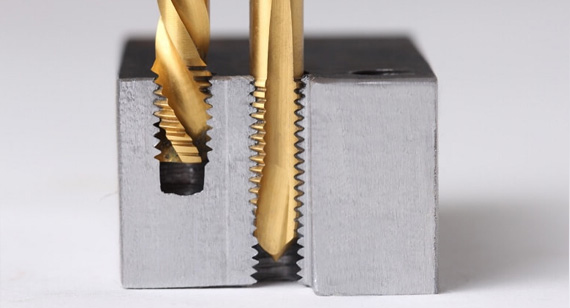
Reaming Holes: Reaming holes are created by enlarging an existing hole to achieve a precise diameter with a smooth finish. Reaming is often used in conjunction with other machining processes to achieve tight tolerances and a high-quality surface finish.
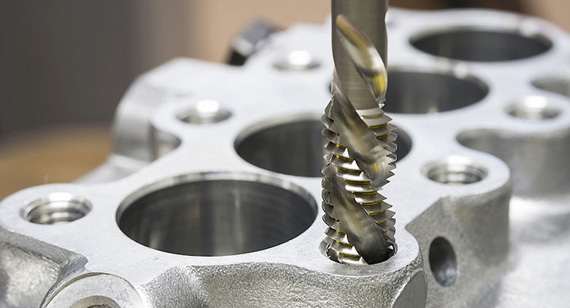
Drilling and tapping are two distinct machining processes used to create threaded holes. Drilling involves creating a hole in a workpiece using a drill bit, which prepares the workpiece for threading. Tapping, on the other hand, is the process of cutting internal threads into the drilled hole using a tap. While drilling focuses on creating the hole itself, tapping is responsible for forming the threads that allow a fastener to be screwed into the hole. Both processes are essential in creating functional threaded holes for various applications.
There are three primary types of thread taps, each designed for different threading tasks:
Taper Taps: Taper taps have a gentle taper at the end, with several cutting edges gradually engaging the material. This design makes taper taps ideal for starting threads, especially in hard materials or for beginners.
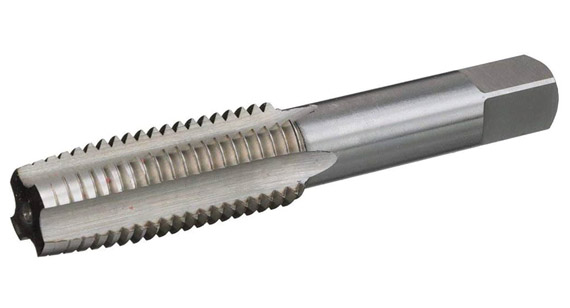
Plug Taps: Plug taps have fewer tapered threads and more full-sized cutting edges. They are used to continue threading after the initial taper tap has started the thread. Plug taps are versatile and commonly used for threading through holes.
Bottom Taps: Bottom taps have full-sized cutting edges with minimal or no taper, making them suitable for threading the bottom of blind holes. They are used to complete threads in holes where the tap cannot pass through the other side.
Bottom Tap is Mainly Used For:
Bottom taps are primarily used in blind holes where threads need to be cut all the way to the bottom. This is essential in applications where the fastener must engage fully with the threads for a secure connection, even in confined spaces.
Several factors should be considered when processing threaded holes to ensure accuracy and quality:
Threaded Hole Processing Methods: Cutting, Forming
Using a Forming Tap: Forming taps create threads by deforming the material rather than cutting it. This method is suitable for ductile materials and produces stronger threads due to work hardening.
Using a Cutting Tool: Cutting taps remove material to create threads and are versatile for various materials. This method is commonly used in most CNC machining services. While both methods produce threaded holes, the choice depends on factors like hole size, material hardness, and whether the hole is blind or through.
Use Standard Thread Sizes Whenever Possible: Using standard thread sizes ensures compatibility with off-the-shelf fasteners and reduces the need for custom tools or fasteners.
Use Threaded Hole Diameters: Ensure that the hole diameter is appropriate for the tap being used, as this affects the thread engagement and strength.
Consider Inclined Surfaces: When tapping on inclined surfaces, special care must be taken to ensure the tap enters perpendicular to the surface to prevent misalignment and cross-threading.
Main Types of Threaded Holes:
Blind Threaded Holes: These holes are threaded to a specific depth without breaking through the other side of the material. They are commonly used in applications where one side of the workpiece must remain intact.
Blind Hole Dimensioning: Proper dimensioning is crucial for blind holes to ensure the full engagement of threads without over-penetrating and damaging the workpiece.
Through Threaded Holes: These holes are threaded all the way through the material, allowing a fastener to pass entirely through and be secured with a nut or another fastening method.
Hole Depth: The depth of the hole is a critical factor, especially for blind holes. Ensuring the correct depth prevents issues like incomplete threading or tap breakage.
Threaded and tapered holes serve different purposes and have distinct characteristics:
Definition: A threaded hole has internal threads that match a corresponding fastener, while a tapered hole narrows in diameter as it deepens, often used for self-sealing connections like pipe threads.
Shape: Threaded holes have a consistent diameter, while tapered holes have a conical shape that allows for a tighter seal as the fastener is inserted.
Create: Threaded holes are created using taps or thread mills, while tapered holes are typically created using specialized taps or reamers designed for the taper.
Application: Threaded holes are used for mechanical fastening, while tapered holes are often used in fluid and gas systems where a leak-proof connection is required.
At VMT, we specialize in precision CNC machining parts, including the creation of threaded holes. Our state-of-the-art CNC machining factory offers custom CNC machining and CNC prototype machining services to meet the diverse needs of our clients. Whether you need standard threaded holes or complex custom threading, our experienced team ensures that every part meets the highest standards of quality and precision.

Machining threaded holes is a fundamental process in manufacturing, essential for creating secure and reliable connections in various applications. By understanding the different types of threaded holes, the methods used to create them, and the factors that influence their quality, manufacturers can ensure the success of their projects. Whether you're working on automotive parts, aerospace components, or consumer electronics, threaded hole processing is a critical aspect of precision CNC machining.

What Materials Can Be Tapped?
Most metals and plastics can be tapped, including steel, aluminum, brass, and various polymers. The choice of tap and processing method may vary depending on the material's hardness and ductility.
Can a Damaged Threaded Hole Be Repaired?
Yes, damaged threaded holes can often be repaired using methods such as helicoil inserts, welding and re-tapping, or oversized taps.
What Is the Difference Between a Threaded Hole and a Tapped Hole?
A threaded hole refers to any hole with internal threads, while a tapped hole specifically refers to a hole that has been threaded using a tap.
Why Is Thread Processing Called Tapping?
The term "tapping" comes from the tool used, a "tap," which is used to cut internal threads within a hole.
What Is the Difference Between Tapping and Rolled Thread?
Tapping cuts threads into a hole, while rolled threading forms threads by displacing material with high-pressure rollers, resulting in stronger threads.
What Is the Difference Between Drilling and Threading?
Drilling creates the initial hole, while threading (or tapping) creates the internal threads within that hole.
How to Tap a Screw Hole in Metal?
To tap a screw hole in metal, first drill the hole to the correct size, then use a tap to cut the threads, applying cutting fluid to reduce friction and prevent tap breakage.
What Are the Three Types of Tapping?
The three types of tapping are taper tapping, plug tapping, and bottom tapping, each used for different stages of threading and types of holes.
What Is the Difference Between Tapping and Threading?
Tapping is a form of threading specifically for creating internal threads in a pre-drilled hole, while threading can refer to creating either internal or external threads.
Can Threaded Inserts Be Tapped?
Yes, threaded inserts can be tapped, although it's often more common to insert them into a pre-drilled hole. Tapping an insert may be necessary for certain repair applications.
Can Thread Forming Taps Cut?
No, thread-forming taps do not cut material; they form threads by displacing the material within the hole, creating stronger threads without removing any material.
This comprehensive guide covers all aspects of machining threaded holes, from basic concepts to advanced techniques, providing valuable insights for anyone involved in CNC machining and manufacturing. By mastering these techniques, you can ensure that your threaded holes are precise, durable, and suitable for their intended applications.
